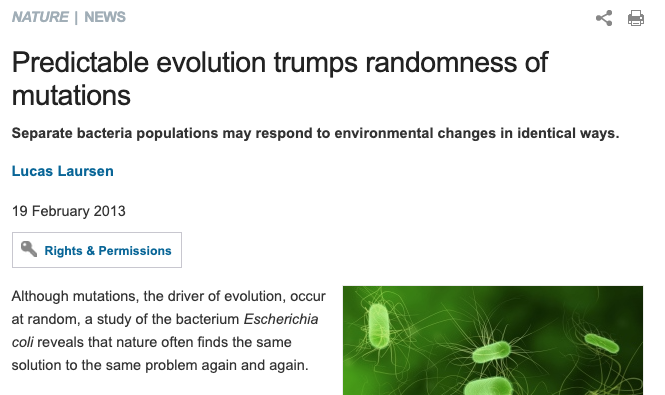Bad takes #4. Attacking the phrase “mutation-driven.”
Unfamiliar ideas are often mis-identified and mis-characterized. It takes time for a new idea to be sufficiently familiar that it can be debated meaningfully. We look forward to those more meaningful debates. Until then, fending off bad takes is the order of the day! See the Bad Takes Index.
In regard to reports of mutational biases influencing the changes involved in molecular adaptation, Svensson and Berger (2019) write
Despite the importance of mutations in these two studies, we emphasize that selection ultimately drove these adaptive allele frequency changes, rather than evolution being ‘mutation-driven’ as some might claim [1,7,8,13].
Actually the “mutation-driven” language is advocated in reference #1 (Nei’s book), but not in the other 3 sources cited, which are Yampolsky and Stoltzfus ( 2001), Stoltzfus (2006) and Stoltzfus and Cable (2014).
The authors object that, whereas the term “drive” refers to a cause that drives an allele to fixation, the changes implicated in the cited studies reflect selective fixation rather than fixation by mutation. The implication is that sources 1, 7, 8 and 13 advocate a theory of population transformation, not by reproductive replacement (via selection or drift), but by mutation pressure, i.e., the cumulative effect of many events of mutational conversion, which is generally a bad idea for reasons pointed out by Kimura (1980), although there are cases where it makes sense, e.g., loss of a complex character (for a more thorough explanation, see Bad take #2).
But of course, fixation by mutation pressure is not the theory advocated in Nei’s 2013 book Mutation-Driven Evolution, nor the other sources cited, nor sources such as this (note the title):
Nor is this what Pennings, et al. (2022) mean when they clarify that “our study is focused on the dynamics of adaptation and reversal in the context of point mutation-driven, stepwise evolution, rather than evolution through horizontal gene transfer or plasmid conjugation”. Nor is this what Tenaillon (2014) means when he writes
“In particular, the long-term evolution of 12 replicate populations of Escherichia coli by R.E. Lenski unraveled a succession of mutation fixations that reached up to 10 % fitness effect (Lenski & Travisano 1994). Large effect mutations appeared therefore to be the drivers of adaptation.”
Furthermore, Svensson and Berger (2019) surely know that authors such as ourselves or Masatoshi Nei, a famous population geneticist, are not advocating fixation by mutation pressure rather than by selection (or drift). For instance, the equation from Yampolsky and Stoltzfus that they recreate in Box 1 is based explicitly on the probability of fixation for a beneficial allele given by Haldane (1927).
That is, Svensson and Berger are making what is called a “bad-faith argument”, an argument that they know is wrong but which they use anyway, trusting that the argument gain favor with naive readers.
One must remember that the piece by Svensson and Berger (2019) is not a serious scholarly analysis, but a parody of Bad Synthesis Apologetics, a Sokal’s hoax exposing that— when the topic is either post-modernist cultural analysis or the status of evolutionary theory— it is possible to “publish an article liberally salted with nonsense if (a) it sounded good and (b) it flattered the editors’ ideological preconceptions.”
With their cheeky “mutation-driven” objection, the authors are parodying the kind of bad-faith argument that does not address any genuine issue of dispute, but is simply a way to score points with the kind of guileless reader who thinks Masatoshi Nei needs a lesson in basic population genetics from Svensson and Berger. It is a long-standing part of Synthesis culture to believe that critics of orthodoxy behave irrationally and hold views with obvious flaws.

If we take away this false pretense, the remaining issue is semantic: (1) does “mutation-driven” refer distinctively to the case in which mutation is a cause of allele fixation, i.e., the mutation pressure theory of evolution, or (2) does an additional meaning of “driving” exist that is more explanatory, justifying the use of “mutation-driven” for the case in which character and timing of evolutionary change depends on the character and the timing of mutations.
The issue is readily resolved by examining the usage of “drive” in evolutionary discourse. Does the literature of evolutionary biology restrict the “drive” language to causation only? The answer is clearly negative. Here is a tiny sample of recent uses from the technical literature:
- “Effective Population Size Drives Model State-Space Selection” (section heading)
- “Epistasis between antibiotic resistance mutations drives the evolution of extensively drug-resistant tuberculosis” (title)
- “Population growth as a driver of initial domestication in Eastern North America.” (title)
- “There is a growing appreciation of the role that the biophysical properties of protein stability, aggregation and degradation have in fitness and disease. Moreover, these properties have been identified as significant factors in many cases of adaptive and compensatory evolution. These properties — and not function — seem to be the forces driving much of protein evolution.” (text from article)
- “Transcription-related mutations and GC content drive variation in nucleotide substitution rates … (title)
Population size is clearly a condition, not a change-making causal process. Therefore, when our colleagues refer to population size “driving” something, this indicates an explanatory and not causal-mechanistic meaning of “drive.” The non-causal nature is unmistakable in the first example above, because what is being “driven” by population size is model choice, which does not physically exist in the realm of biology, but represents an abstraction in the realm of modeling. A cause X and its direct effect Y must occur in the same place, the locale of causation.
Note that this meaning of “drive” can be used — and often is used — with the concept of selection, i.e., we can talk about selection driving a thing, without that thing being an allele frequency, e.g.,
More generally, based on a purely descriptive analysis of patterns, e.g., a statistical analysis, scientists may refer to the predominant explanatory factor as the factor that “drives” the pattern. In this kind of claim, the implied chain of causation may be absent or unclear. As argued by Green and Jones (2016) in regard to “constraints,” scientists sometimes prefer a non-mechanistic language, because this allows them to discuss formal relations applicable to some system, without having to commit to a (potentially problematic) hypothesis for a mechanistic cause.
This does not mean that all uses of “drive” are equally welcome. When some authors above write that “These properties — and not function — seem to be the forces driving much of protein evolution” they are literally saying that properties are forces, which is gibberish. I find many of these uses of “drive” to be unhelpful, especially when results could be described more clearly using causal language (but see below).

To summarize, in their parody of Synthesis sophistry, Erik and David cover the “mutation-driven” issue with a delightfully empty misrepresentation sandwich, layered with bogus arguments. The meat is a weak semantic argument to the effect that the word “drive” must refer to population-genetic cause in the classic sense, a mass-action pressure that might cause allele fixation. Examples from the research literature demonstrate conclusively that the word “drive” simply does not have this restriction. This nutrient-poor semantic filling is sandwiched between two misrepresentations of the cited sources: (1) that they advocate the “mutation-driven” language (this is false for 3 of the 4 sources cited), and (2) that they invoke mutation pressure as a cause of fixation (this is false for all 4 sources).
Finally, note that we are having this discussion about language precisely because our customary causal language is insufficient. In the shifting-gene-frequencies theory of the Modern Synthesis, evolutionary causes are mass-action pressures (per statistical physics) that may cause allele fixations, e.g., selection and drift are seen as causes because they are potential causes of fixation. This theory of causes makes no distinction between shifts of a frequency from 0 to 1/N (or 1/(2N)) vs shifts among non-zero frequencies. When Haldane (1927) and Fisher (1930) addressed the potential for mutation-induced trends, they treated mutation as a cause of mass shifting and dismissed it as unimportant.
We have no other recognized causal language than statistical “forces” (“pressures”) at the population level. In particular, we have no recognized causal language for the effects of the introduction process: such effects are most often mis-described in terms of mutation pressure, or they are described indirectly or passively, as a matter of background conditions, or using the explanatory language of constraints or chance. The legacy of neo-Darwinism is that selection is the paradigm of a cause, and any other factor is judged to be causal or not depending on how much it acts like selection. Because the introduction process is not like selection at all, it has not been recognized as a causal process.
Attempts to describe the role of mutation actively rather than passively, with strong verbs, are certain to provoke opposition from the reactionary elements parodied by Svensson and Berger (2019). As I have written elsewhere, this position is cultural, not scientific: the reactionaries are culturally rigid but scientifically flexible. They will accept saltations (non-infinitesimal changes, major-effect alleles) and orthogenesis (tendencies due to internal biases) if the evidence demands it, but they will never endorse the terms “saltation,” “internal biases in evolution” or “orthogenesis,” because this would reveal a heretical departure from tradition. They will not reject mutation-biased adaptation due to biases in the introduction process, but they will describe it with old words while referencing dead authorities, in order to anchor new concepts in traditional sources (see also Bad Takes #5).
References
Kimura M. 1980. Average time until fixation of a mutant allele in a finite population under continued mutation pressure: Studies by analytical, numerical, and pseudo-sampling methods. Proc Natl Acad Sci U S A 77:522-526.